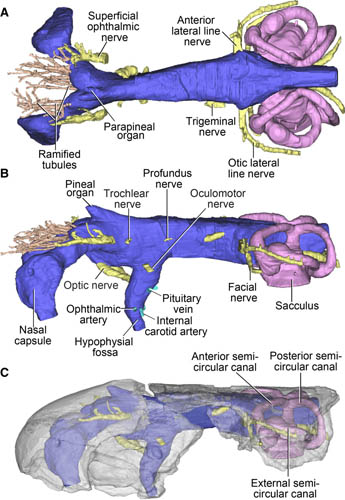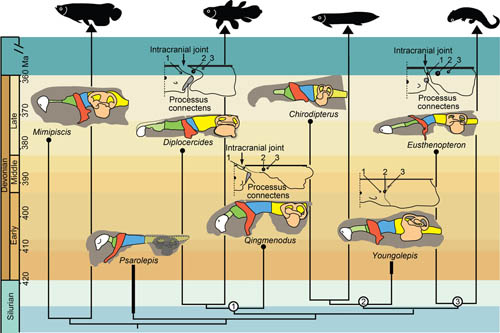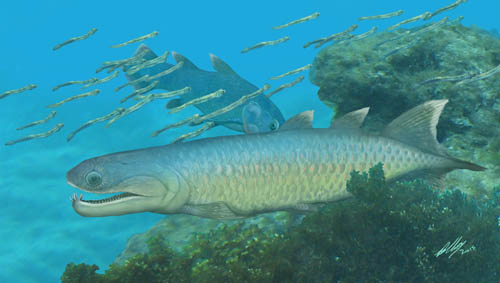
Crown or modern sarcopterygians comprise three major groups: coelacanths, lungfishes and tetrapods. With the exception of the tetrapods, sarcopterygians have a long evolutionary history of diversity decline and are nowhere near as diverse today as they were at the beginning of their history. They differ substantially from stem or primitive sarcopterygians such as Guiyu and Psarolepis, and a lack of transitional fossil taxa limits our understanding of the origin of the modern group.
Onychodonts are an exclusively Devonian group of mostly marine predatory sarcopterygians. Until recently, they were represented by only six named genera and seem to have characteristics of both primitive and modern sarcopterygians, but are difficult to place because of insufficient anatomical information, particularly in braincase components.
In a study published June 3 in the journal Science Advances, Drs. LU Jing and ZHU Min, of the Institute of Vertebrate Paleontology and Paleoanthropology (IVPP) of the Chinese Academy of Sciences, and their collaborators described newly discovered skull material of Qingmenodus, an onychodont from South China about 409 million years ago, using high-resolution computed tomography to image internal structures of the braincase. This study provides the first detailed interpretation of internal neurocranial anatomy in onychodonts, and helps us to understand the sequence of character acquisition in the early evolution of sarcopterygians, illuminating the early evolution and diversification of modern sarcopterygians.
The new specimens of Qingmenodus, including a completely ossified anterior cranial portion (IVPP V16003.5) and a posterior cranial portion (IVPP V16003.6), were collected from the type site of Qingmenodus yui during field trips from 2009 to 2012. The anterior cranial portion is referred to as Qingmenodus yui based on the shared ornamentation and comparable size with the holotype of Qingmenodus yui (IVPP V16003.1). The new posterior cranial portion has not preserved the ventral part of the otic capsules; however, its preserved part matches well with the holotype, such as vermiculate impressions on the dermal surface, and the elongate otic shelf.
Qingmenodus, one of the oldest known onychodonts from the Early Devonian of South China, shows a virtually complete set of neurocranial structures of an onychodont. It exhibits a mosaic of features present in both primitive sarcopterygians and coelacanths.
“In addition to its remarkable similarities with primitive sarcopterygians in the ethmosphenoid portion, Qingmenodus exhibits coelacanth-like neurocranial features in the otic region,” said lead author Dr. LU Jing. “It thus further bridges the morphological gap between primitive sarcopterygians, such as Guiyu, Psarolepis and Achoania, and modern sarcopterygians, and provides unique insights into the sequence of neurocranial character acquisition involved in the origin and early diversification of the latter.”
“Our completely reconstructed virtual cranial endocast of Qingmenodus allows extensive comparisons with other sarcopterygians, in particular those that have been studied by serial grinding or computerized tomography (CT) scanning,” said Dr. ZHU Min, project designer and study co-author. “It provides the first detailed interpretation of internal neurocranial anatomy in onychodonts, and helps us to understand the sequence of character acquisition in the early evolution of sarcopterygians.”
“Our phylogenetic analysis based on a revised data set unambiguously assigns onychodonts to crown sarcopterygians as stem coelacanths. Qingmenodus thus bridges the morphological gap between stem sarcopterygians and coelacanths, and helps to illuminate the early evolution and diversification of crown sarcopterygians,” said co-author Dr. Per Erik Ahlberg, of Sweden’s Uppsala University.
This work was supported by the Major Basic Research Projects of China, the National Natural Science Foundation of China, the National Major Scientific Instrument and Equipment Development Project of China, the Swedish Research Council, and a Wallenberg Scholarship from the Knut and Alice Wallenberg Foundation.

Fig. 1 Qingmenodus yui, an early onychodont from Pragian, South China. (A) Anterior cranial portion (IVPP V16003.5) in ventral view. (B) Posterior cranial portion (IVPP V16003.6) in ventral view. (C) Anterior cranial portion (IVPP V16003.5) in right lateral view. (D) Tentative restoration of the natural shape of the neurocranium in right lateral view. Scale bars, 2 mm. (D) Not drawn to scale. (Image by LU Jing)

Fig. 2 Digital neurocranial endocast restorations of Qingmenodus yui. (A to C) In dorsal view (A), lateral view (B), and left lateral view with transparent braincase (C). Main color key: blue, cranial cavity; yellow, cranial nerves; light orange, tubule system; light purple, inner ear cavity. (Image by LU Jing)

Fig. 3 Comparison of the brain cavities of selected Devonian sarcopterygians in a temporally calibrated cladogram. (Image by LU Jing)

Fig. 4 Life Reconstrution of Qingmenodus yui. (Image by Brian Choo)

86-10-68597521 (day)
86-10-68597289 (night)

52 Sanlihe Rd., Xicheng District,
Beijing, China (100864)

